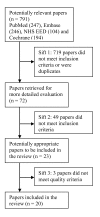Cost-effectiveness of injury prevention - a systematic review of municipality based interventions
- PMID: 20831790
- PMCID: PMC2945985
- DOI: 10.1186/1478-7547-8-17
Cost-effectiveness of injury prevention - a systematic review of municipality based interventions
Abstract
Background: Injuries are a major cause of mortality and morbidity which together result in avoidable societal costs. Due to limited resources, injury prevention interventions need to demonstrate cost-effectiveness to justify their implementation. However, the existing knowledge in this area is limited. Consequently, a systematic review is needed to support decision-making and to assist in the targeting of future research. The aim of this review is to critically appraise the published economic evidence of injury prevention interventions at the municipal level.
Methods: A search strategy was developed to focus a literature search in PubMed, Embase, Cochrane and NHS EED. Studies were eligible for inclusion if they were economic evaluations of injury prevention interventions that could be implemented by municipalities; had a relevant comparison group; did not include any form of medication or drug use; and were assessed as having at least an acceptable quality from an economic point of view. Articles were screened in three steps. In the final step, studies were critically appraised using a check-list based on Drummond's check-list for assessing economic evaluations.
Results: Of 791 potential articles 20 were accepted for inclusion. Seven studies showed net savings; four showed a cost per health score gained; six showed both savings and a cost per health score gained but for different time horizons and populations; and three showed no effect. The interventions targeted a range of areas such as traffic safety, fire safety, hip fractures, and sport injuries. One studied a multi-targeted community-based program. Only six articles used effectiveness data generated within the study.
Conclusions: The results indicate that there are injury prevention interventions that offer good use of societal resources. However, there is a lack of economic evidence surrounding injury prevention interventions. This lack of evidence needs to be met by further research about the economic aspects of injury prevention interventions to improve the information available for decision-making.
Figures
References
-
- Injuries. http://www.who.int/topics/injuries/en/
-
- World Health Organisation. World Health Statistics 2009. Geneva; 2009.
-
- Kommunbaserat säkerhetsfrämjande arbete [Municipality based safety promotion work] http://www.imh.liu.se/pub/jsp/polopoly.jsp?d=9952&a=118045
LinkOut - more resources
Full Text Sources
Miscellaneous


